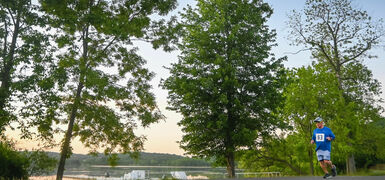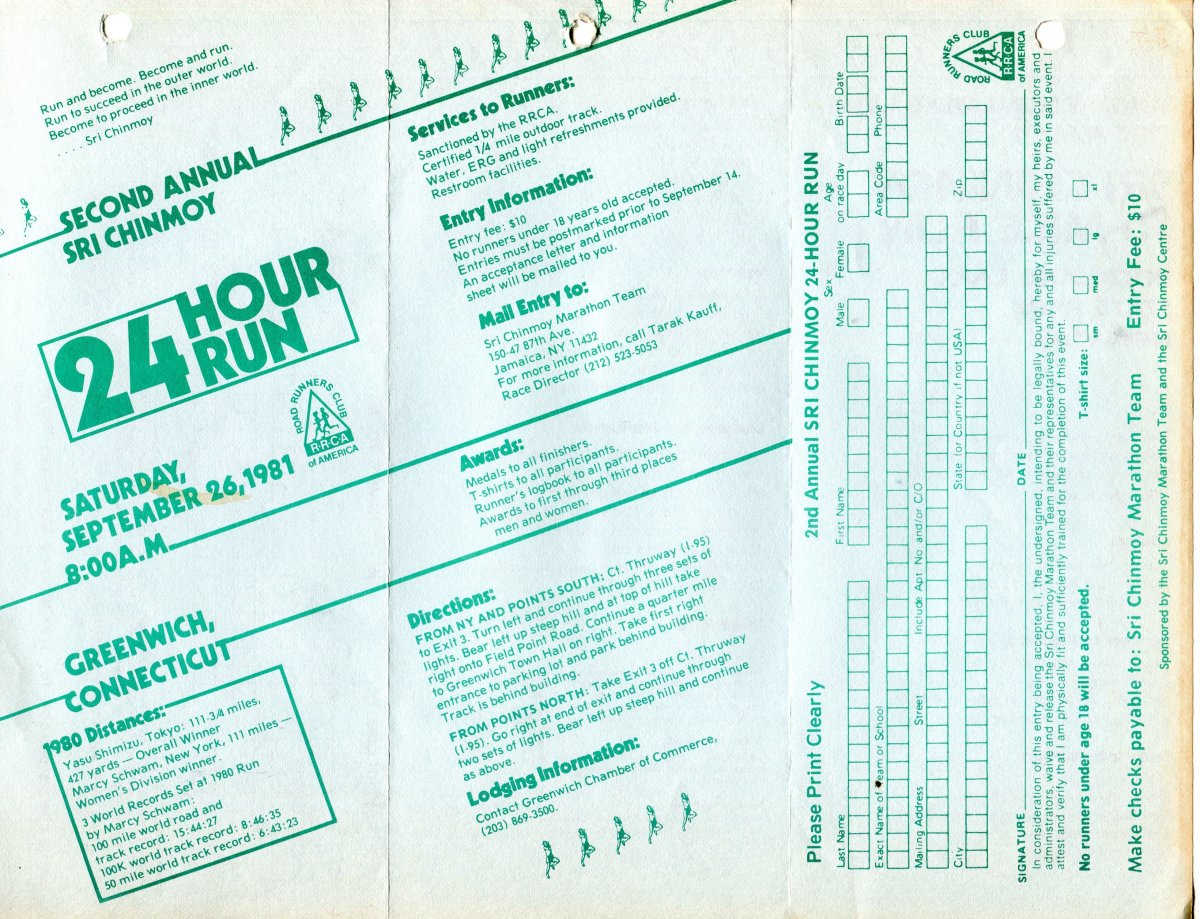Reminisces from Sahishnu Sczesiul....
The Second Annual Sri Chinmoy 24-Hour Race was held on the same cinder track in Greenwich, Connecticut, from September 26–27, 1981. This race became the focus of the SCMT for nearly a whole year, even with our schedule packed with shorter races, half-marathons, full marathons and triathlons as well as a 70-mile event later in November on a road course. The field had grown from six to then 40 very good to excellent ultra-runners of all sizes and shapes. Bob Van Deusen, 33, from Portland, OR, held the US national record of 145 miles, and was primed to accent his first visit to the east coast with a win. George Gardiner from Hope Valley, RI, 39, was a fast runner and reigning US 100 mile record holder (13:22:09) looking to reach new plateaus. Cahit Yeter and Sue Medaglia, both from the Bronx, both at age 46, were primed to do well after good training, although Sue had only been able to run for two weeks prior to the event due to an injury in August.
The 40 runners were off from the start-line after a brief moment of meditation from Sri Chinmoy. The atmosphere was cordial in the beginning as the big field passed the counting area, with a pack of five fast runners continually lapping the rest of the field. The pack was left behind by George Gardiner, as he led everyone through 50km- 3:46:08; and 50 miles- 6:07:08- the latter a single-age US best. He even had the fastest time through 100 km - 8:09:39.
Ron Bomberger from Mannheim, PA was closest pursuer at the time, and looked very smooth three laps back. Jim Roser, 50, of Beaver Falls, PA stayed close to Ron, but was a mile and a half behind his friend as early places changed and shifted as heat and humidity grew a little in the afternoon. Bob Van Deusen tried to stay with the four or five easterners, but they were too fast for his pace, and any attempts to follow Gardiner in front seemed ill advised. Ron Berby from Ann Arbor,Michigan had stayed outside the five but kept his distance. Cahit Yeter, however, was in that pack and allowed the other runners to set the pace, his smooth style wasting little precious energy as the setting sun was covered with a few clouds.
When Yeter had reached the 100-mile mark (13:49:24- best US 45-49 of the year) he had assumed the lead, with only Ron Bomberger, Jim Roser, Ron Berby and a slowing George Gardiner in formation behind him. One of three women in the race, Sue Medaglia, was moving quite well and had begun following the faster male runners as the evening set in. She would get to 100 miles in an age leading 18:41:42 with no signs of distress. She was passing men and climbing up the scoreboard from fourteenth to eighth to fifth.
Cahit Yeter was rolling during the dark, small hours of the night, focused on taking a new record for 200 km. The old record belonged to Bob Van Deusen (19:40:59). Cahit reached the mark in 18:10:56. He set his sights on new goals. 150 miles seemed possible, with 5 hours 49 minutes left. He passed Al Howie’s North American record of 149 miles 706 yards with over an hour remaining. He held on for the whole 24-Hour duration, reaching 155 miles 1182 yards as the horn sounded, ending the event, With his wife and daughters looking on, Cahit basked in the lights of a North American 24 Hour record, national record, course and event record, and he moved into sixth place all time in the world for 24 hours.
Ron Bomberger held on for second place with a fine effort of 138 miles 1509 yards, a personal best and single –age national record. Ron Berby was able to hold off any challengers for third place with 133 miles 1093 yards, a huge personal best.
Sue Medaglia laid claim to a new women’s world track record with 126 miles 763 yards. She eclipsed the mark set by Sue Ellen Trapp of 123 miles 593 yards. Sue also became the first woman in history to pass the 200 km barrier, reaching the mark in 23:41:08.
As the race came to an end and the dust settled, 24 runners had passed 100 miles, the most ever in a 24-hour event. Numerous records were set, and the experiment of a race for a full day on a cinder and dirt track proved to be as surprising, challenging, difficult, silly, painful, breath-taking and wonderful, all in one full day of running.
Comments from Runners
Below are some words from competitors who had their eyes and ears open to the whole experience.
Bob Marshall - (in an article he wrote on the race, published in Ultrarunning magazine November 1981).
“There is always something special about Sri Chinmoy and his group. Through ultra-marathoning I have found what I consider to be an unparalleled inner contentment, yet I can only wonder in awe at the peace and love radiating from each of the Sri Chinmoy followers. At the far corner of the track two young women sang beautiful lyric songs about running and living. On nearly every lap I was greeted and cheered by name. When it was dark, the track was lighted with dozens of candles in white bags, which cast a mystical glow around the far turns.“
“The combination of the 24 Hour event and Sri’s race support group produced an unforgettable event, and fitting surroundings for the world class performances which resulted.”
“At the award ceremony I felt as we were all winners; it was tremendous! We sat in a circle and shared the moment- perhaps the first time that 24 runners bested 100 miles in a 24-hour race. World and national records were set by masters and junior performers. Sri Chinmoy composed a song that the group sang to us. Van Deusen and Yeter shook hands; Cahit had broken Bob’s American record for 200 km, as well as his national 24-hour record. Sri Chinmoy presented the awards. I had my brief moment, barely able to stand and accept Sri’s hand. Suddenly it was over- the greatest 24-hour race ever held on American soil. I’ll be back”
Ron Berby wrote an article for The Michigan Runner a running newspaper that circulated throughout the state and the region.
“ Sue Medaglia and I mumbled at each other where previously we waxed wit and frivolity. Survivors must consider survival. The chants of some of the support people began to mention self-pity and doubt. They sure knew where I was. At least someone knew. A couple girls held up a huge drawing of a smile. I needed a boost and got it by mugging an equally bright grin as I went by- still crazy after all those hours. 7:30am and 130 miles came nearly together. Suddenly, time changed. For 23 and one-half hours we had been trying to kill it. Now we couldn’t get enough of it. Runners ran faster. Walkers trudged. Limpers limped faster.
With 10 minutes left, Steve Vargo, a 5’7” stump of muscle from Erie, PA pulled up to me. He announced ’You and I are going to go fast.’ “We are? I exclaimed”. He answered by accelerating. He was right. We went fast………it took great concentration on form for me to go with Vargo. We ran the last mile in under 6 minutes!
Moments before I was going to sag, I heard a distant whistle and dropped the sandbag with my race number penned on it- and thankfully stumbled to a stop. I found myself part of one of the clumps of humanity scattered around the favored quarter mile. There was a moment of profuse handshaking, hugging, laughing and crying. Vargo’s hug was like that of a shaved gorilla. I walked toward the official’s tent with arms raised and fists clenched. I heard someone screaming, “Wasn’t that something?!!! Wasn’t that something?!!! It turned out to be me.”
The 24-hour event was catching on, not only around the US but worldwide, as athletes chose to test themselves a various distances and in set-time events, like the one-day and even 48-hour affairs. On the extreme end of the sport existed the revival of the six-day races from the late 19th century, as well as point-to-point races from cities, or across states, or even across countries, as history would later reveal. Our humble 24-hour races began serving the running community by offering inspiration to the athletes, as well as building standards for race administration and implementation, especially in the care of the athletes during the races. Sri Chinmoy begged us to treat the athletes with the utmost respect and with a sincere concern for their endeavors. To this day, the ounce of care has been essential in the formation of good feelings among athletes in sport.






 Marshall, Bob. "Medaglia Passes 200 Km for 24 Hour World Record." Ultrarunning. November 1981.
Marshall, Bob. "Medaglia Passes 200 Km for 24 Hour World Record." Ultrarunning. November 1981. Cahit Yeter en route to his record breaking run. Photo: Bhashwar
Cahit Yeter en route to his record breaking run. Photo: Bhashwar
 Sri Chinmoy (l) with ultra legend Ted Corbitt at the awards ceremony of the Sri Chinmoy 24-Hour Run. Photo: Shraddha Howard
Sri Chinmoy (l) with ultra legend Ted Corbitt at the awards ceremony of the Sri Chinmoy 24-Hour Run. Photo: Shraddha Howard









